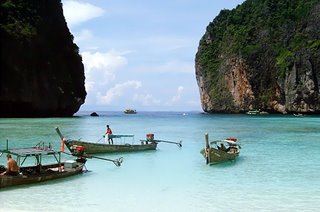Phi Phi Le Island in Thailand
~
Wednesday, September 13, 2006

The Phi Phi Islands are located in Thailand, between the larger island of Phuket and the mainland. They are politically part of Krabi province, most of which is on the mainland.
Phi Phi Don
Ko Phi Phi Don ("ko" meaning "island" in the Thai language) is the largest island of the group, and is the only island with permanent inhabitants, although the beaches of the second largest island, Ko Phi Phi Lee (or "Ko Phi Phi Leh"), are visited by many people as well. There are no accommodation facilities on this island, but it is just a short boat ride from Ko Phi Phi Don. The rest of the islands in the group, including Bida Nok, Bida Noi, and Bamboo Island, are not much more than large limestone rocks jutting out of the sea.Phi Phi Don
Phi Phi Don was initially populated by Muslim fishermen during the late 1940s, and later became a coconut plantation. The Thai population of Phi Phi Don remains more than 80 present Muslim.Phi Phi History
"The cliffs are the reason we chose Phi Phi Le because in the story, the beach that the characters are living on is surrounded by the high sea cliffs from the sea. So, it's a secret. It's like a big secret, swimming pool and beach in private and this is the attraction for the characters. That's why we have to use Phi Phi Le." - Andrew Macdonald, producer of "The Beach"Phi Phi is situated in Krabi Province in southern Thailand
 The two islands that make up this group (Phi Phi Don aPhi Phi Donnd Phi Phi Le) are about 40 kilometres south-west of Krabi City. The islands are about equidistant from Krabi and Phuket (to the north-west). The islands are famed for their spectacular landscapes. Rock climbers are attracted by the breathtaking cliffs, with tall sheer walls of limestone. Nature lovers, meanwhile, find a haven in the islands' transparent seas and corel beds, which are home to a wide range of sea life.
The two islands that make up this group (Phi Phi Don aPhi Phi Donnd Phi Phi Le) are about 40 kilometres south-west of Krabi City. The islands are about equidistant from Krabi and Phuket (to the north-west). The islands are famed for their spectacular landscapes. Rock climbers are attracted by the breathtaking cliffs, with tall sheer walls of limestone. Nature lovers, meanwhile, find a haven in the islands' transparent seas and corel beds, which are home to a wide range of sea life.
0 comments:
Post a Comment